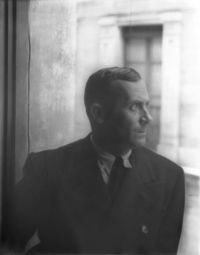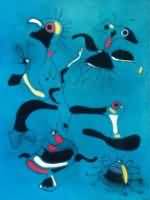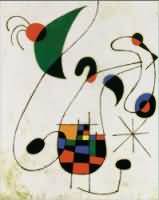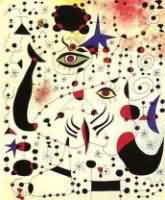Joan Mir車 i Ferr角 (April 20, 1893 每 December 25, 1983) was a Catalan
(Spanish) painter, sculptor, and ceramist born in Barcelona, Catalonia,
Spain to the family of a goldsmith and watchmaker. His work has been
interpreted as Surrealism, a sandbox for the subconscious mind, a re-
creation of the childlike, and a manifestation of Catalan pride. In numerous
interviews dating from the 1930s onwards, Mir車 expressed contempt for
conventional painting methods and his desire to "kill", "murder", or "rape"
them in favor of more contemporary means of expression.
Young Mir車 was drawn towards the arts community that was gathering in
Montparnasse and in 1920 moved to Paris. There, under the influence of the
poets and writers, he developed his unique style: organic forms and
flattened picture planes drawn with a sharp line. Generally thought of as a
Surrealist because of his interest in automatism and the use of sexual
symbols (for example, ovoids with wavy lines emanating from them), Mir車*s
style was influenced in varying degrees by Surrealism and Dada, yet he
rejected membership to any artistic movement in the interwar European years.
Andr谷 Breton, the founder of Surrealism, described him as "the most
Surrealist of us all." Mir車 confessed to creating one of his most famous
works, Harlequin's Carnival, under similar circumstances:
"How did I think up my drawings and my ideas for painting? Well I'd come
home to my Paris studio in Rue Blomet at night, I'd go to bed, and sometimes
I hadn't any supper. I saw things, and I jotted them down in a notebook. I
saw shapes on the ceiling..."
In 1926, he collaborated with Max Ernst on designs for Sergei Diaghilev.
With Mir車's help, Ernst pioneered the technique of grattage, in which he
troweled pigment onto his canvases. Mir車 married Pilar Juncosa in Palma de
Mallorca on October 12, 1929; their daughter Dolores was born July 17, 1931.
Shuzo Takiguchi published the first monograph on Mir車 in 1940. In 1959, Andr
谷 Breton asked Mir車 to represent Spain in The Homage to Surrealism
exhibition together with works by Enrique T芍bara, Salvador Dal赤, and Eugenio
Granell.
Mir車 dabbled in architecture when he designed the Maeght Foundation museum
in Saint-Paul-en-For那t, France, which was completed in 1964.
By not becoming an official member of the Surrealists, Mir車 was free to
experiment with any artistic style that he wished without compromising his
position within the group and being accused of not being a ※true§
Surrealist. He pursued his own interests in the art world, both within and
between groups which politicked and jockeyed for prominence. Mir車*s
artistic autonomy, in that he did not adhere to any one particular style, is
reflected in his work and his willingness to work with several media.
In an interview with biographer Walter Erben, Mir車 expressed his dislike for
art critics, saying, they "are more concerned with being philosophers than
anything else. They form a preconceived opinion, then they look at the work
of art. Painting merely serves as a cloak in which to wrap their emaciated
philosophical systems."
Four-dimensional painting is a theoretical type of painting Mir車 proposed in
which painting would transcend its two-dimensionality and even the three-
dimensionality of sculpture.
In his final decades Mir車 accelerated his work in different media producing
hundreds of ceramics, including the Wall of the Moon and Wall of the Sun at
the UNESCO building in Paris. He also made temporary window paintings (on
glass) for an exhibit. In the last years of his life Mir車 wrote his most
radical and least known ideas, exploring the possibilities of gas sculpture
and four-dimensional painting.
He died bedridden, at his home in Palma, Mallorca on December 25, 1983. |



 |



